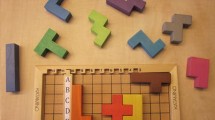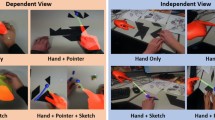Abstract
Collaborative Mixed Reality (MR) technologies enable remote people to work together by sharing communication cues intrinsic to face-to-face conversations, such as eye gaze and hand gestures. While the role of visual cues has been investigated in many collaborative MR systems, the use of spatial auditory cues remains underexplored. In this paper, we present an MR remote collaboration system that shares both spatial auditory and visual cues between collaborators to help them complete a search task. Through two user studies in a large office, we found that compared to non-spatialized audio, the spatialized remote expert’s voice and auditory beacons enabled local workers to find small occluded objects with significantly stronger spatial perception. We also found that while the spatial auditory cues could indicate the spatial layout and a general direction to search for the target object, visual head frustum and hand gestures intuitively demonstrated the remote expert’s movements and the position of the target. Integrating visual cues (especially the head frustum) with the spatial auditory cues significantly improved the local worker’s task performance, social presence, and spatial perception of the environment.
















Similar content being viewed by others
Notes
References
Adcock M, Anderson S, Thomas B (2013) RemoteFusion: real time depth camera fusion for remote collaboration on physical tasks. In: Proceedings of the 12th ACM SIGGRAPH international conference on virtual-reality continuum and its applications in industry. pp 235–242
Alem L, Li J (2011) A study of gestures in a video-mediated collaborative assembly task. Adv Hum-Comput Interact 2011:1
Bai H, Sasikumar P, Yang J, Billinghurst M (2020) A user study on mixed reality remote collaboration with eye gaze and hand gesture sharing. In: Proceedings of the 2020 CHI conference on human factors in computing systems, pp 1–13
Barde A, Ward M, Helton WS, Billinghurst M, Lee G (2016) Attention redirection using binaurally spatialised cues delivered over a bone conduction headset. In: Proceedings of the human factors and ergonomics society annual meeting, vol 60. SAGE Publications Sage CA, Los Angeles, pp 1534–1538
Beck S, Kunert A, Kulik A, Froehlich B (2013) Immersive group-to-group telepresence. IEEE Trans Visual Comput Graph 19(4):616–625
Billinghurst M, Bowskill J, Jessop M, Morphett J (1998) A wearable spatial conferencing space. In: Digest of papers. Second International Symposium on Wearable Computers (Cat. No. 98EX215). IEEE, pp 76–83
Billinghurst M, Kato H (2002) Collaborative augmented reality. Commun ACM 45(7):64–70
Blessenohl S, Morrison C, Criminisi A, Shotton J (2015) Improving indoor mobility of the visually impaired with depth-based spatial sound. In: Proceedings of the IEEE International Conference on Computer Vision Workshops, pp 26–34
Brewster S, Walker V (2000) Non-visual interfaces for wearable computers. In: IEE Colloquium (Digest). IEE; 1999, p 6
Brooke J (2013) SUS: a retrospective. J Usability Stud 8(2):29–40
Brooke J et al (1996) SUS-a quick and dirty usability scale. Usability Eval Ind 189(194):4–7
Buxton W, Moran T (1990) Europarc’s integrated interactive intermedia facility (IIIF): early experiences. In: Multi-user interfaces and applications, vol 11, p 34
Chen H, Lee AS, Swift M, Tang JC (2015) 3D collaboration method over hololens\(^{\text{TM}}\) and skype\(^{\text{ TM }}\) end points. In: Proceedings of the 3rd international workshop on immersive media experiences. ACM, pp 27–30
DeVincenzi A, Yao L, Ishii H, Raskar R (2011) Kinected conference: augmenting video imaging with calibrated depth and audio. In: Proceedings of the ACM 2011 conference on computer supported cooperative work, pp 621–624
Fussell SR, Kraut RE, Siegel J (2000) Coordination of communication: effects of shared visual context on collaborative work. In: Proceedings of the 2000 ACM conference on computer supported cooperative work, pp 21–30
Gao L, Bai H, Piumsomboon T, Lee G, Lindeman RW, Billinghurst M (2017) Real-time visual representations for mixed reality remote collaboration
Gauglitz S, Nuernberger B, Turk M, Höllerer T (2014) World-stabilized annotations and virtual scene navigation for remote collaboration. In: Proceedings of the 27th annual ACM symposium on user interface software and technology, pp 449–459
Gross M, Gross M, Würmlin S, Naef M, Lamboray E, Spagno C, Kunz A, Koller-Meier E, Svoboda T, Van Gool L et al (2003) blue-c: a spatially immersive display and 3D video portal for telepresence. In: ACM Transactions on Graphics, vol 2. ACM, pp 819–827
Gupta K, Lee GA, Billinghurst M (2016) Do you see what I see? The effect of gaze tracking on task space remote collaboration. IEEE Trans Visual Comput Graph 22(11):2413–2422
Härmä A, Jakka J, Tikander M, Karjalainen M, Lokki T, Hiipakka J, Lorho G (2004) Augmented reality audio for mobile and wearable appliances. J Audio Eng Soc 52(6):618–639
Harms C, Biocca F (2004) Internal consistency and reliability of the networked minds measure of social presence
Higuch K, Yonetani R, Sato Y (2016) Can eye help you? Effects of visualizing eye fixations on remote collaboration scenarios for physical tasks. In: Proceedings of the 2016 CHI conference on human factors in computing systems. ACM, pp 5180–5190
Huang W, Kim S, Billinghurst M, Alem L (2018) Sharing hand gesture and sketch cues in remote collaboration. J Visual Commun Image Represent 58:428–438
Joachimczak M Liu J, Ando H (2018) Downsizing: the effect of mixed-reality person representations on stress and presence in telecommunication. In: 2018 IEEE international conference on artificial intelligence and virtual reality, pp 140–143
Kim S, Lee G, Sakata N, Billinghurst M (2014) Improving co-presence with augmented visual communication cues for sharing experience through video conference. In: 2014 IEEE international symposium on mixed and augmented reality, pp 83–92
Kim S, Lee GA, Sakata N, Dünser A, Vartiainen E, Billinghurst M (2013) Study of augmented gesture communication cues and view sharing in remote collaboration. In: 2013 IEEE international symposium on mixed and augmented reality, pp 261–262
Koleva N, Hoppe S, Moniri MM, Staudte M, Bulling A (2015) On the interplay between spontaneous spoken instructions and human visual behaviour in an indoor guidance task. In: CogSci
Lee GA, Teo T, Kim S, Billinghurst M (2017) Mixed reality collaboration through sharing a live panorama. In: SIGGRAPH Asia 2017 mobile graphics & interactive applications, pp 1–4
Lee GA, Teo T, Kim S, Billinghurst M (2018) A user study on mr remote collaboration using live 360 video. In: 2018 IEEE international symposium on mixed and augmented reality, pp 153–164
Loomis JM, Golledge RG, Klatzky RL (1998) Navigation system for the blind: auditory display modes and guidance. Presence 7(2):193–203
Müller R, Helmert JR, Pannasch S (2014) Limitations of gaze transfer: without visual context, eye movements do not to help to coordinate joint action, whereas mouse movements do. Acta Psychol 152:19–28
Orts-Escolano S, Rhemann C, Fanello S, Chang W, Kowdle A, Degtyarev Y, Kim D, Davidson PL, Khamis S, Dou M et al (2016) Holoportation: virtual 3D teleportation in real-time. In: Proceedings of the 29th annual symposium on user interface software and technology. ACM, pp 741–754
Piumsomboon T, Lee GA, Hart JD, Ens B, Lindeman RW, Thomas BH, Billinghurst M (2018) Mini-me: an adaptive avatar for mixed reality remote collaboration. In: Proceedings of the 2018 CHI conference on human factors in computing systems. ACM, New York, NY, USA, pp 46:1–46:13
Sandra HG (2006) Development of NASA TLX: result of empirical and theoretical research. San Jose State University, California
Sawhney N, Schmandt C (2000) Nomadic radio: speech and audio interaction for contextual messaging in nomadic environments. ACM Trans Comput-Hum Interact 7(3):353–383
Smith HJ, Neff M (2018) Communication behavior in embodied virtual reality. In: Proceedings of the 2018 CHI conference on human factors in computing systems pp 1–12
Sodnik J, Tomazic S, Grasset R, Duenser A, Billinghurst M (2006) Spatial sound localization in an augmented reality environment. In: Proceedings of The 18th Australia conference on computer–human interaction: design: activities, artefacts and environments, pp 111–118
Sousa M, dos Anjos RK, Mendes D, Billinghurst M, Jorge J (2019) Warping deixis: distorting gestures to enhance collaboration. In: Proceedings of the 2019 CHI conference on human factors in computing systems. ACM, New York, NY, USA, pp 608:1–608:12
Tang TJ, Li WH (2014) An assistive eyewear prototype that interactively converts 3D object locations into spatial audio. In: Proceedings of the 2014 ACM international symposium on wearable computers, pp 119–126
Tecchia F, Alem L, Huang W (2012) 3D helping hands: a gesture based MR system for remote collaboration. In: Proceedings of the 11th ACM SIGGRAPH international conference on virtual-reality continuum and its applications in industry, pp 323–328
Teo T, Lawrence L, Lee GA, Billinghurst M, Adcock M (2019) Mixed reality remote collaboration combining 360 video and 3D reconstruction. In: Proceedings of the 2019 CHI conference on human factors in computing systems. ACM, New York, NY, USA, pp 201:1–201:14
Teo T, Lee GA, Billinghurst M, Adcock M (2018) Hand gestures and visual annotation in live 360 panorama-based mixed reality remote collaboration. In: Proceedings of the 30th Australian conference on computer–human interaction, pp 406–410
Tikander M, Karjalainen M, Riikonen V (2008) An augmented reality audio headset. In: Proceedings of the 11th International Conference on Digital Audio Effects (DAFx-08), Espoo, Finland
Tomczak M, Tomczak E (2014) The need to report effect size estimates revisited. An overview of some recommended measures of effect size. Trends Sport Sci 21(1):19–25
Velamkayala ER, Zambrano MV, Li H (2017) Effects of hololens in collaboration: a case in navigation tasks. In: Proceedings of the human factors and ergonomics society annual meeting, vol 61. SAGE Publications Sage CA: Los Angeles, CA, pp 2110–2114
Villegas J, Cohen M (2010) “Gabriel”: geo-aware broadcasting for in-vehicle entertainment and localizability. In: AES 40th International Conference
Vorderer P, Wirth W, Gouveia FR, Biocca F, Saari T, Jäncke L, Böcking S, Schramm H, Gysbers A, Hartmann T et al (2004) Mec spatial presence questionnaire. Retrieved 18 Sept 2015
Walker A, Brewster S (2000) Spatial audio in small screen device displays. Pers Technol 4(2–3):144–154
Walker A, Brewster S, McGookin D, Ng A (2001) Diary in the sky: a spatial audio display for a mobile calendar. In: People and computers XV—interaction without frontiers. Springer, pp 531–539
Yang J, Frank Y, Sörös G (2019) Hearing is believing: synthesizing spatial audio from everyday objects to users. In: Proceedings of the 10th augmented human international conference. ACM, p 28
Yang J, Sörös G (2018) Spatial audio for human-object interactions in small AR workspaces. In: Proceedings of the 16th annual international conference on mobile systems, applications, and services. ACM, p 518
Author information
Authors and Affiliations
Corresponding author
Additional information
Publisher's Note
Springer Nature remains neutral with regard to jurisdictional claims in published maps and institutional affiliations.
Rights and permissions
About this article
Cite this article
Yang, J., Sasikumar, P., Bai, H. et al. The effects of spatial auditory and visual cues on mixed reality remote collaboration. J Multimodal User Interfaces 14, 337–352 (2020). https://doi.org/10.1007/s12193-020-00331-1
Received:
Accepted:
Published:
Issue Date:
DOI: https://doi.org/10.1007/s12193-020-00331-1




